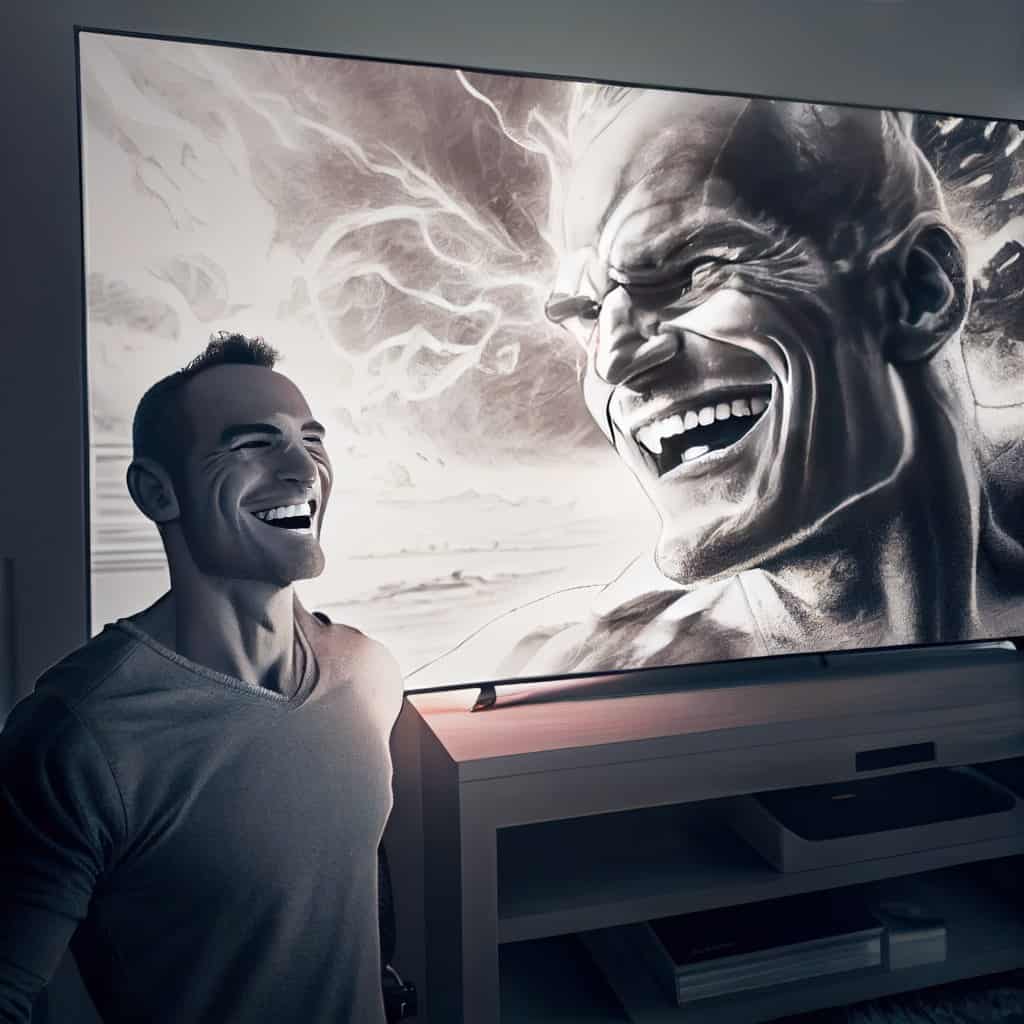Tired of watching the same old shows in their grainy pre-HD glory? Ready to upgrade your screen resolution and take your viewing experience up a notch? Then grab your glasses, unfold a comforter on the couch, and prepare to geek out – HDTV is here! The latest generation of ultra-high-definition TVs has been hitting shelves over the past few months, bringing with them an entirely new wave of entertainment possibilities.
So if you’re ready to hit peak visual clarity (and don’t mind some flashy marketing jargon), this blog post is for you. Let’s explore what makes HDTV even higher definition than before, why there are still options available in legacy resolutions, and how quickly we can pass beyond 1080p into eye-popping 4K bliss.
The History of HDTV
High-definition television (HDTV) has revolutionized how people view television and has been the subject of considerable hype over the last decade. HDTV first gained popularity in Japan in the early 1990s, leading to an effort by companies such as Sony, Philips, and Panasonic to make HDTV universally available. The United States first adopted HDTV technology in 1998 as part of a collaborative effort between major broadcasters and electronics manufacturers.
In 2011, the Federal Communications Commission (FCC) mandated a switch from analog broadcast signals to digital broadcast signals across all major networks. This allowed broadcasters to send out programs in high-definition with significantly improved picture clarity and sound quality. In addition, this allowed HDTVs to access premium channels such as HBO or Showtime through their cable or satellite provider.
The latest advancements in HDTV technology include 4K resolution, which was first released in 2013. This higher resolution allows viewers to access even greater detail, contrast, and clarity than ever before. Additionally, smart TVs are increasingly being seen as more than just televisions; these sets allow users to access streaming services like Netflix or Hulu without additional devices such as game consoles.
HDTV continues to evolve today with remarkable advances in resolution, picture quality, color accuracy, sound quality, and accessibility options that provide unparalleled viewing experiences for viewers around the world.
How HDTV Works

High-definition television (HDTV) is a digital broadcasting technology that sends and receives signals much more effectively than traditional analog broadcasting. Its signal comprises two elements: a ” compressed” signal containing no extra information and an “uncompressed” signal with the full data attached. This combination creates a clearer, sharper image on the TV screen.
HDTV broadcasts using special antennas in the form of small boxes or cable systems designed to pick up digital broadcast signals from licensed broadcasters. These digital signals are sent to an HDTV tuner, which decodes the signal and displays it in high-definition resolution on an HDTV monitor. Unlike traditional TV sets, HDTV sets are equipped with special cables that accommodate these digital signals by having more pins in their connector than traditional set-top boxes have.
Beyond sending digital signals, high-definition television also provides superior picture and sound quality because the data contained within its broadcasts carry more information than analog broadcast signals. To ensure full compatibility with existing equipment when switching over to HD, most modern HD receivers come equipped with an analog/digital converter to properly convert incoming analog broadcasts into a form that can be interpreted correctly by the machine. By taking advantage of higher frame rates and resolutions, HDTV provides much richer colors, color accuracy, and improved clarity than traditional TV programming.
The Benefits of HDTV
High Definition Televisions (HDTVs) are now commonplace worldwide, offering superior picture and audio quality. They offer superior resolution and sound, giving a clear, vivid image.HDTV programming has grown significantly, with most networks broadcasting in HD format. HD provides an improved image with more detail, sharper lines, and richer colors than traditional definition televisions (SD TVs), making it easier to enjoy movies, sports, and other content at home.
In addition to providing better picture quality, HDTVs provide an improved cinematic experience. Many high-definition displays include extras like wide color gamut support for accurate color reproduction; 120/240Hz refresh rate for smoother motion; simulated surround audio, which amplifies the on-screen action through built-in speakers; and 4K Ultra resolution, which packs four times the detail of standard HD resolution into the same screen size – making it possible to experience images as if you were actually there.
HD models have become increasingly affordable over time as well, making today’s high-end TVs much more accessible than a few years ago when they first became popular. And most HDTV models now allow you to access online services like Netflix or Hulu right from your TV’s interface, making them a great way to stay connected and entertained. With the amazing benefits of owning an HDTV today, it’s no surprise they have become so popular!
The Different Types of HDTV
HDTVs come in various styles, from box-style sets to curved displays. The most popular types of televisions are LED and LCD, but there are other options if you want to shop around. Each type has its advantages and limitations, so it’s worth taking the time to learn about the differences before purchasing.
LED TVs are slim and produce one of the brightest images available. This type of television is known for its rich color accuracy, low power consumption, and high-quality picture. On the downside, LED TVs are expensive compared to their LCD counterparts.
LCD TVs use liquid crystals to generate images on the screen. They typically produce sharp details and deep blacks. They also have low response time with no motion blur or ghosting during fast-moving scenes. However, they don’t have as rich of a color palette due to lower backlighting intensity than LED models.
Plasma flat-screen TVs still have fans because they provide crisp images with vibrant colors and natural skin tones that work well in bright rooms with ambient lighting present. However, this type of television tends to be bulky and heavier than LCD or LED sets because the gases inside the plasma cells require thicker display panels than those found on LCD or LED sets
4K Ultra HDTVs offer incredible detail with four times more pixels than a standard HDTV image – making for incredibly sharp digital content even from further away from your display device! Ultra High Definition technology takes home entertainment up a notch, offering premium picture quality upscaling capabilities, innovative features like Smart TV streaming content access & Ultra High Dynamic Range (HDR) processing performance! Even though these televisions may cost more than other types plus require additional investments into media or programming components, their benefits are certainly measurable & make any movie night special!
HDTV Resolution
The picture resolution of HDTV technology is measured by the number of vertical lines (or pixels) that make up the complete picture. Standard HDTV resolutions include 720p, 1080i, and 1080p.
720p has a resolution of 1280×720 pixels, with each frame displayed at a progressive rate or all at once. This picture format is becoming more popular because of its compatibility with high-definition and non-high-definition content.
1080i picture resolution consists of 1920×1080 interlaced frames, with each frame displayed alternating to give viewers increased clarity and sharpness. Although less bandwidth is required to view 1080i images than their 1080p counterparts, some consumers may notice a slight blurring effect when viewing fast-moving objects on their screens in this format.
Finally, the highest quality formats for HDTV are those produced by the 1080p specification. With this format, the entire image is shown as one full frame with a resolution of 1920×1080. The sharpness and clarity achieved by this standard make it ideal for home theater enthusiasts who want to fully enjoy content from Blu-ray discs or other sources without any discernible blur or latency issues in playback.
HDTV Compatibility
Making sure your HDTV is compatible with all your electronic components is one of the more important considerations when selecting an HDTV. The latest models typically include HDMI (High-Definition Multimedia Interface) and component connectors, but older HDTVs might not support newer component types.
HDMI is the most popular input type found on modern displays as it offers superior quality over other connection types. If you want to connect a DVD player, gaming system, or any other external device that requires vivid audio and video, HDMI provides one of the best options for doing this. It’s important to check whether or not your HDTV has 4K or Ultra High Definition (UHD) capability before connecting certain devices.
Component compatibility is also an issue that should be considered when buying a new TV. Most digital TVs have component outputs for hooking up gaming systems like Xbox 360, PS3, or Wii U. Unless you have an older TV with only VGA ports – also known as D-Sub connectors – every modern display should have component outputs for connecting digital video equipment with ease.
It’s also important to remember that more than one kind of connection may be available per component type; some monitors might offer DisplayPort connectivity in addition to HDMI, while others might provide composite inputs only. As a general rule of thumb, try to match your desired device connection type to those provided by the TV before making a purchase decision, as there are more than a dozen different connections available today, and they vary in terms of quality and price range as well as compatibility levels across different HDTV brands and models.
HDTV Connections
Today, many available HDTV connections depend on your needs and television type. Digital Video Interface (DVI) is a connection specifically designed for high-definition displays and can transfer higher resolutions than other cables. DVI may offer better picture quality depending on your TV’s ports than HDMI.
High-Definition Multimedia Interface (HDMI) is one of the newer HDTV connections, offering digital audio and video signals in a single cable to reduce clutter behind your TV. Most HDTVs now include at least one (and often several) HDMI ports, so chances are you already have it installed in your home entertainment center. Some of today’s newest gaming systems require HDMI connections to work correctly.
Component video connections use individual cables for each signal. In contrast, the composite video uses all signals in one cable, reducing clutter but lacking some sharper edges of the HD signals encoded with component video.
Composite Video is an older HDTV connection that once transfers analog data such as audio and video but does not give users the sharp detail offered by more recent connections like DVI or HDMI. This type of connection was practical when standard-definition TVs were still popular, but due to its weak encoding method is no longer preferred for HDTVs.
Finally, VGA stands for Video Graphics Array; this type of cable was used with early computers, and connecting an old computer monitor to an HDTV will not provide a good quality picture because VGA does not correctly format images for playback on flat-panel displays or projectors with higher resolutions than a traditional CRT computer monitor could support without extensive image manipulation from both ends.
HDTV Settings
HDTVs are highly customizable and feature many different settings to allow the user to optimize their experience. Each setting affects how the picture looks, so it’s important to understand how each parameter affects the display of your HDTV.
The most common settings are:
- Brightness: Controls the white level of your picture. Set it too low, and you’ll miss details in dark scenes; set it too high, and bright areas may appear washed out or blown out.
- Contrast: Controls the overall dynamic range of your picture by increasing/decreasing “the difference between light and dark areas.” Too high will cause a washed-out look; too low will cause a dull look.
- Color: Adjusts the saturation level for all colors on your HDTV’s display. A color setting that is too high will make objects appear unnatural, while a color setting that is too low will make them appear dull and greyish.
- Sharpness: This control adjusts how you want to “enhance” edges at different luminance levels to create an effect that objects are more defined or sharper than they are. Overusing sharpness will lead to false contours appearing in some parts of images as “halos” around edges which can reduce image quality significantly.
- Color Temperature/White Balance Settings: These settings offer choices usually listed as “Warm,” “Cool,” “Normal,” or other variations such as 6500K or 5500K indicative of specific color temperatures on industry-calibrated displays; warm yielding more yellow hues while cool yields bluer hues, etc.
- Gamma Settings: Normally, this setting would automate itself, but with some displays, there is a manual option that affects mid-level grays by changing how quickly the image transitions from black-to-white levels (darker grays blooming into brighter grays). Low values result in darker pictures with a less pronounced shadow definition, while higher gamma values from 1.8 (the recommended setting) up to 2.2 yields brighter pictures with more detail in dark areas such as shadows etc.
HDTV Troubleshooting
When it comes to HDTV, a problem with resolution or image quality can be incredibly irritating. If you’re trying to fix an issue with your television, it can be helpful to run through a few possible solutions.
Start by checking your TV’s connection settings and ensuring all the cables are securely in place. If you still cannot get any image on the screen, test your HDMI cable with another device and make sure all the inputs are working properly. You may also want to check if the resolution settings are incorrect on your device or TV — both HDTVs and many devices provide special settings optimized for higher-resolution images.
If these initial checks do not yield results, you may have a bigger problem on your hands that is related to hardware issues. Make sure that all components of your HDTV are functioning properly, including any external parts like memory cards and remote controls — each item might be required for optimal HDTV experience. In addition, take a look at the refresh rate of your television display, as this could be an indicator of lower-than-normal performance levels for HD video playback.
Also, try disconnecting any other electronic audio/visual components to help track down the source of interference or bad signal manipulation that might result in picture distortion or sound issues with your HDTV setup. Suppose none of these methods resolve the issue. In that case, you may need to contact a professional repair service that specializes in HDTV troubleshooting and restoring picture quality back to its normal level.
The Future of HDTV

HDTV is a rapidly evolving technology, and with the introduction of new technologies comes key enhancements to the way we view entertainment. As companies continue to push for higher resolution screens and increased color depth, there are now more options than ever for those looking to enjoy their favorite TV shows and movies in stunning quality.
High Dynamic Range (HDR) has become a popular feature on HDTVs for improved image brightness and detail. With HDR enabled, content appears more realistic and closer to what the human eye would naturally see. This is achieved by widening the range of brightness values that can be displayed on-screen. Additionally, a wide color gamut (WCG) allows a wider array of colors than conventional TVs produce, providing viewers with an even more authentic viewing experience.
Curved displays have also become increasingly popular but offer minimal visual benefits compared to flat-panel TVs; however, they offer a unique aesthetic appeal and an immersive experience suitable for home cinemas or dedicated media rooms. Motion Interpolation technology helps reduce juddering due to upscaling of content from broadcast or streaming sources yielding significantly smoother visuals with less blur.
Finally, as streaming services continue to proliferate with 4K content, there is no better way to experience your favorite high-definition footage than on Ultra HDTVs which can deliver four times the resolution and clarity of 1080P screens so that you never miss out on all the details that filmmakers intended you see in their work. Heading into the future, we expect more exciting advancements from HDTVs, making them even better suited for our Entertainment needs beyond 2022!
